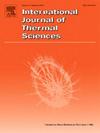Bubble behavior and heat transfer mechanisms of deposited nanoparticles in pool-boiling process
IF 4.9
2区 工程技术
Q1 ENGINEERING, MECHANICAL
International Journal of Thermal Sciences
Pub Date : 2025-07-16
DOI:10.1016/j.ijthermalsci.2025.110151
引用次数: 0
Abstract
Deposited nanoparticles critically influence solid-liquid interactions and bubble growth in pool-boiling heat transfer, but the underlying mechanism of heat transfer induced by the combined wettability of the deposited nanoparticles and substrate remains unclear. Here, the effects of the size (12–192 nm3) and wettability (neutral and hydrophilic) of Cu nanoparticles deposited on wettable (hydrophobic, neutral, and hydrophilic) Cu substrates were investigated from a nanoscale perspective via molecular dynamic simulations. The results indicate a small size (12–108 nm3) initiates bilateral nucleation on nanoparticles followed by upward coalescence, resulting in detachable vapor films. However, neutral nanoparticle–substrates with a nanoparticle size of 192 nm3 are characterized by bubbles nucleating simultaneously on the sides and top, detaching after bidirectional coalescence; this reduces the vapor film formation time by 50 % and the bubble nucleation volume growth rate by 89.2 %. Finally, hydrophilic nanoparticle–substrates exhibit top-dominated nucleation and coalescence pathways, preventing vapor film formation. Regardless of the substrate, for hydrophilic nanoparticles, bubble nucleation consistently initiates on the nanoparticle sides and proceeds upward. Additionally, enhanced nanoparticle–substrate wettability decreases the interfacial thermal resistance by 87.9 %, while larger nanoparticles reduce it by 75.1 %. Hydrophilic nanoparticle–substrates strengthen facilitate the formation of a solid-like liquid layer. Reducing the interfacial thermal resistance promotes liquid Ar atoms to absorb more energy, resulting in enhanced heat transfer.
池沸过程中沉积纳米颗粒的气泡行为及传热机理
沉积的纳米颗粒对池沸腾传热中的固液相互作用和气泡生长有重要影响,但沉积的纳米颗粒和衬底的联合润湿性诱导的传热机制尚不清楚。本文通过分子动力学模拟,从纳米尺度的角度研究了Cu纳米颗粒沉积在可湿性(疏水、中性和亲水性)Cu基质上的尺寸(12 - 192nm3)和润湿性(中性和亲水性)的影响。结果表明,小尺寸(12-108 nm3)会引发纳米颗粒的双边成核,然后向上聚并,形成可分离的气膜。而中性纳米颗粒- 192nm3的纳米颗粒基底,其特征是气泡在两侧和顶部同时成核,在双向聚并后分离;这使气膜的形成时间缩短了50%,气泡成核体积增长率降低了89.2%。最后,亲水纳米颗粒-底物表现出顶部主导的成核和聚结途径,阻止了气膜的形成。无论底物是什么,对于亲水纳米颗粒,气泡成核始终从纳米颗粒的侧面开始并向上进行。此外,纳米颗粒-衬底润湿性的增强使界面热阻降低了87.9%,而更大的纳米颗粒使界面热阻降低了75.1%。亲水纳米颗粒基板强化有利于固体状液体层的形成。界面热阻的降低促进了液态Ar原子吸收更多的能量,从而增强了传热。
本文章由计算机程序翻译,如有差异,请以英文原文为准。
求助全文
约1分钟内获得全文
求助全文
来源期刊

International Journal of Thermal Sciences
工程技术-工程:机械
CiteScore
8.10
自引率
11.10%
发文量
531
审稿时长
55 days
期刊介绍:
The International Journal of Thermal Sciences is a journal devoted to the publication of fundamental studies on the physics of transfer processes in general, with an emphasis on thermal aspects and also applied research on various processes, energy systems and the environment. Articles are published in English and French, and are subject to peer review.
The fundamental subjects considered within the scope of the journal are:
* Heat and relevant mass transfer at all scales (nano, micro and macro) and in all types of material (heterogeneous, composites, biological,...) and fluid flow
* Forced, natural or mixed convection in reactive or non-reactive media
* Single or multi–phase fluid flow with or without phase change
* Near–and far–field radiative heat transfer
* Combined modes of heat transfer in complex systems (for example, plasmas, biological, geological,...)
* Multiscale modelling
The applied research topics include:
* Heat exchangers, heat pipes, cooling processes
* Transport phenomena taking place in industrial processes (chemical, food and agricultural, metallurgical, space and aeronautical, automobile industries)
* Nano–and micro–technology for energy, space, biosystems and devices
* Heat transport analysis in advanced systems
* Impact of energy–related processes on environment, and emerging energy systems
The study of thermophysical properties of materials and fluids, thermal measurement techniques, inverse methods, and the developments of experimental methods are within the scope of the International Journal of Thermal Sciences which also covers the modelling, and numerical methods applied to thermal transfer.
 求助内容:
求助内容: 应助结果提醒方式:
应助结果提醒方式:


